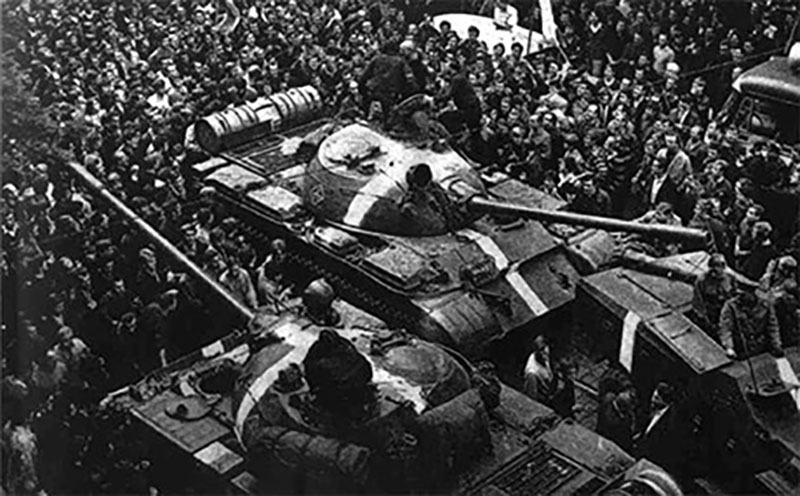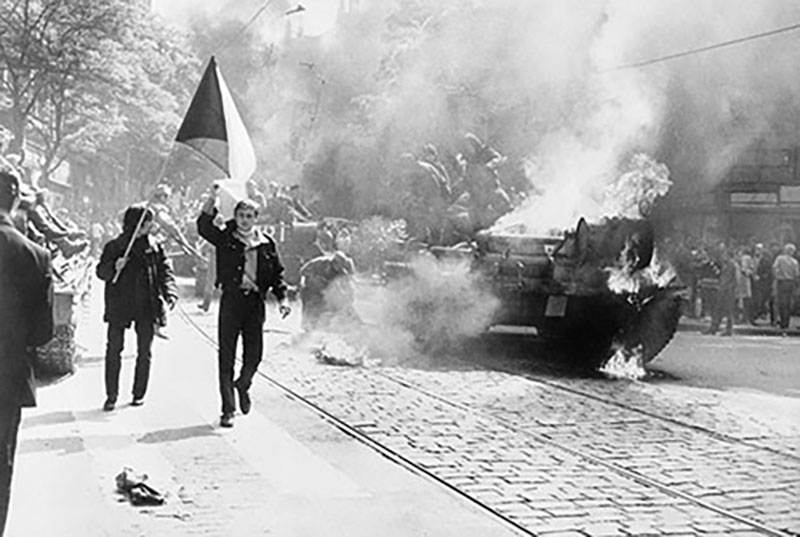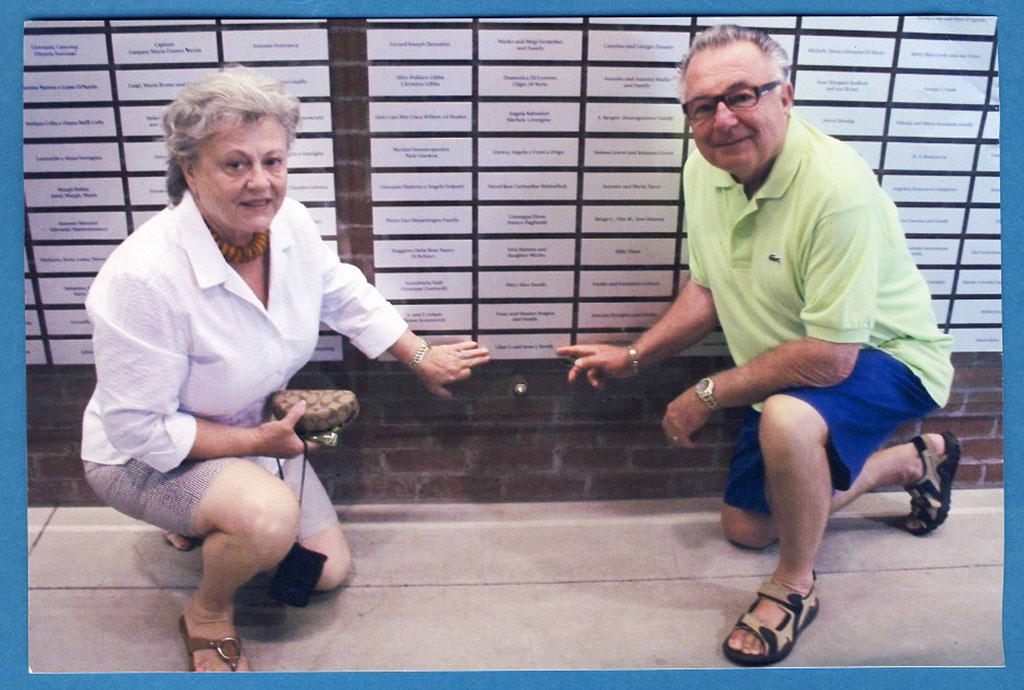by Jan Raska, PhD, Historian
(Updated August 21, 2020)
Introduction: The Prague Spring and the Soviet-led Invasion of Czechoslovakia
In 1968, liberal elements within the Communist Party of Czechoslovakia initiated efforts to reform the communist regime from within. Various sectors of the country’s population increasingly resisted participation in communist-led organizations. On 5 January, Alexander Dubček, a Slovak reformer, replaced Antonín Novotný as First Secretary of the Communist Party. In April, Dubček announced a new political programme, “socialism with a human face,” (“socialismus s lidskou tváří”) which saw the implementation of reforms including the elimination of press censorship, the restoration of civic and individual rights, and the liberalization of the economy. As communist reformers implemented their own form of socialism, this period became known as the Prague Spring (Pražské jaro).
In late July, Soviet leader Leonid Brezhnev met with Czechoslovakia’s communist leadership in Čierna nad Tisou, Slovakia. The Soviet delegation informed Czechoslovak leaders that if their reforms continued, they would come with grave consequences. Moscow demanded that the Communist Party in Czechoslovakia remove reformers from key positions. Meanwhile, communist officials in neighbouring Eastern Bloc countries feared that Prague’s reforms would spread to their hardline regimes. In early August, officials from the Soviet Union, Bulgaria, East Germany, Hungary, and Poland agreed to defend Soviet communism from reform and planned “Operation Danube” – in which Warsaw Pact forces would invade Czechoslovakia to suppress the Prague Spring movement and assist in reinstalling hardline communist rule.[1]

Credit: Engramma.it (CC BY-SA 3.0)

Credit: Central Intelligence Agency (Public Domain)
Overnight on 20-21 August 1968, approximately 170,000 soldiers and 4,600 tanks from the Soviet Union, Bulgaria, Hungary, and Poland entered Czechoslovakia.[2] At the time, Western governments, including Canada, had largely believed that a military invasion was unlikely. Canadian officials were surprised by the events in Czechoslovakia. While the federal government condemned the invasion, it also ruled out any military intervention in Central Europe. Canadian officials recognized that a significant number of professionals, skilled workers, and students were outside of Czechoslovakia at the time of the invasion or had fled to the West in the wake of the invasion. Soon after, the federal cabinet established an interdepartmental committee with officials representing Manpower and Immigration, External Affairs, National Health and Welfare, and the Solicitor General – who was responsible for the Royal Canadian Mounted Police – to organize a special program for Prague Spring refugees who wished to permanently resettle in Canada.
Canada Implements a Humanitarian Response: A Special Program for Prague Spring Refugees
The Canadian government soon implemented a humanitarian response that was influenced by its own political and economic self-interest. Thousands of skilled workers and professionals had fled the communist regime in Czechoslovakia and had sought refuge in Austria, Yugoslavia, and other European countries. In early September 1968, the Minister of Manpower and Immigration, Allan J. MacEachen, reported to his cabinet colleagues that “a number of conditions had been waved to facilitate the movement to Canada of Czechoslovak refugees.” Using the 1956 special program for Hungarian refugees as a precedent; Canadian officials relaxed admissions criteria, including medical examinations and security screening, and chartered flights to help bring more than 11,200 Prague Spring refugees to Canada between 8 September 1968, when the first group of refugees arrived in Canada, and 10 January 1969, when the special program was terminated.[3]
Canadian immigration officials in Europe moved quickly to process refugees who had shown interest and applied for permanent resettlement in Canada. Michael Molloy, a former Canadian immigration official and ambassador to Jordan, who joined the Immigration department’s foreign service in 1968 recalls…
…I arrived in Vienna three days after the Russians marched into Prague and crushed…the Prague Spring—the attempt to have a more humane kind of Communism. So the first people I interviewed were Czech refugees. And…it seemed like forever before the government of Canada reacted….it was a very small office…there was just a—the officer in charge and then another fellow and myself. And…I suspect it was a week. But to me it seemed forever. And then, all of a sudden, people started to arrive. And it was clear that we were going to be involved in a movement of Czech refugees and I thought, well, this is going to be wonderful…we spent the next…four weeks signing visas from dusk—dawn to dusk and dusk to dawn. And I’m sure there are thousands of Czechs…in this country today who think I had a great deal to do with their coming to Canada, but all (laughs) I did was sign my name.[4]
Immigration Processing of Refugees at Pier 21 during the 1960s
Many of the Prague Spring refugees, who had applied to come to Canada at Canadian embassies across Europe, arrived by chartered aircraft to major airports across the country. However, a small group of refugees left Czechoslovakia before the invasion and could not be processed during the special program by Canadian officials in Europe because they had travelled by plane to Cuba. In deciding not to return home, these Czechs and Slovaks were forced to seek permanent resettlement elsewhere. They found their way to Pier 21 by disembarking from their planes, during a routine refuelling stopover, at Gander International Airport in Newfoundland, and requesting asylum. Throughout the 1960s, immigration officials and voluntary service agencies at Pier 21 were no strangers to the arrival of individuals who had fled their communist homelands. In the early part of the decade, Cuban refugees had left their planes in Gander and were brought to Pier 21 for processing. The Cubans were detained at Pier 21 until their paperwork could be sorted. Most of them hoped to reach the United States where they had familial and business ties, and where existing Cuban communities could help in their permanent resettlement.
The Prague Spring refugees were also brought to Pier 21 to be detained and processed until they could find suitable accommodations and employment in the city. The latter hinged on their acceptance as landed immigrants. Father J.R. Brown, a Catholic port chaplain who began serving at Pier 21 in 1968, fondly recalls the arrival of the first group of Prague Spring refugees: “the first couple that came up were all smiles, and holding out papers in their hands. As my interpreter listened to them, he started smiling as well. It turned out that the papers were wedding invitations; the couple had planned to be married in Prague the morning of the Russian invasion, and that was still the first thing on their minds.”[5] Brown later received permission to marry the couple and their wedding was attended by other Prague Spring refugees living at Pier 21 or elsewhere in the city.[6]
Defecting at Gander: The Experiences of Libor and Jiřina Roštík
Libor and Jiřina (Irene) Roštík, another couple, defected to the West during a return flight from Havana to Prague. Libor, an engineer, and Jiřina, a technical illustrator and draftswoman, openly supported the socioeconomic liberalization of their homeland during the Prague Spring. Since Libor had to travel to Moscow and Belgrade as part of his work, he “…could see the clouds on the horizon. There were ramblings in Moscow that the Soviets are ready to come to ‘help’ us to make sure that we follow the ‘right way’ of Stalinist socialism.” The Soviet-led Warsaw Pact invasion of their homeland demonstrated to the Roštíks that democratic values would not be permitted to flourish in Czechoslovakia. The couple then decided to leave for the West, but sensed that they would never fully belong in another European country. The Roštíks then set their sights on moving to Canada. Libor notes that he “…always felt that the Canadian culture invites immigrants and that it is a country with enormous resources.”
Recognizing that there was an opportunity to reach Canada by air, Libor contacted his brother-in-law, who worked as an engineer in the Cuban sugar industry and resided in Havana. The relative informed him that flights between Prague and Havana had scheduled refuelling stopovers in Shannon, Ireland and Gander, Newfoundland. The Roštíks then asked their relative to send them a letter requesting that they come visit him in Cuba. After spending two months in the Caribbean communist country and coming to terms with their decision to seek asylum in the West, the Czech couple filled their suitcases with old newspapers, knowing that they would have to leave them on the plane.
On 6 December 1968, Libor and Jiřina Roštík, dressed only in tropical clothing, disembarked from their Czechoslovak Airlines flight during its stopover at Gander. Libor recalls deplaning…
…we tried to keep back. There was a door to the left leading to the cafeteria and there was a door to the right where the immigration officers sat…we turned right and asked for a political asylum. To our surprise, about thirty other passengers followed us. We were met with an utmost courtesy and one of the officers offered to retrieve our personal belongings from the plane. As I was filling the paperwork he accompanied my wife to the plane door, asked for the description of our items and came back with our possessions, which consisted of two bottles of Cuban rum, fifty Cuban cigars and a small transistor radio. And we had our valet of riches – ten US dollars!
In Gander, wearing clothing better suited for tropical weather and Jiřina in high heels, the Roštíks were honked at by passing cars. They were then subsequently transported to the local Holiday Inn where they received vouchers for breakfast the following day. Afterwards, they were flown to Halifax and escorted to Pier 21 for further immigration processing.
The Roštíks Story Continues: From Detention to Dominion Engineering
At Pier 21, the couple was separated, men to the left and women to the right. Libor remembers… “…Irene holding my hand and crying that she will not see me again. We were ushered to austere quarters with bunk beds, which served as a detention centre. Next morning we had to undergo health checks and obtain a medical clearance and we received a schedule for the immigration interviews.” In Pier 21’s detention quarters, the Roštíks met other people from around the world, some quite content to be housed and provided with regular meals. With his broken English, Libor asked the immigration officers to bring him a small table and two chairs so he and his wife could begin to learn English.
During the couple’s interviews, they were informed that if they were accepted as political refugees, they would be permitted to leave detention and enter a six-month government language program for newcomers. Following their admission into Canada, the Roštíks left Pier 21 on 12 December and moved into an apartment on Jubilee Road in Halifax. Upon successful completion of a language test every week, the couple were provided with a $35 weekly allowance. After only three months into their course, the Czech couple moved to Montreal after Libor was offered employment as a project engineer with Dominion Engineering Works.[7]

Credit: Canadian Museum of Immigration at Pier 21 Collection (DI2013.799.3).
Conclusion: One of Canada’s Largest Coordinated Postwar Refugee Movements
Between 1968 and 1969, 14,374 individuals who claimed Czechoslovakia as their country of citizenship entered Canada.[8] Most had come as part of the nearly 12,000 individuals who were resettled in Canada under the special program for Prague Spring refugees. Others, who took longer to decide to leave their homeland or were unable to be processed overseas before the program’s termination found other means to come to Canada.
In the years that followed, individuals able to secure travel documents from the communist authorities in Czechoslovakia continued to defect to the West during refuelling stopovers at Gander and Mirabel International Airport near Montreal. Others took a “vacation” to Yugoslavia, where they claimed refugee status at the Belgrade office of the United Nations High Commissioner for Refugees before boarding a flight for Canada. They came to Canada in search of political freedom and economic opportunity. Today, the resettlement of Prague Spring refugees to Canada, between 1968 and 1969, remains one of this country’s largest coordinated postwar refugee movements. Since then, Canada has continued to resettle refugees in times of sociopolitical upheaval, including over 7,000 Ugandan Asians (1972-1973), some 8,000 Chileans (1973-1978), over 77,000 Vietnamese, Cambodian, and Laotians (1975-1981), and over 40,000 Syrians (2015-2017).[9]
- For further context, see Zdeněk Hejzlar and Vladimír V. Kusin, Czechoslovakia, 1968-1989: Chronology, Bibliography, Annotation (New York: Garland Publishing, 1975).↩
- Jeremi Suri, “The Promise and Failure of ‘Developed Socialism’: The Soviet ‘Thaw’ and the Crucible of the Prague Spring, 1964-1972,” Contemporary European History 15.2 (2006): 153; Geraint Hughes, “British Policy towards Eastern Europe, and the Impact of the ‘Prague Spring’ 1964-1968,” Cold War History 4.2 (2004): 126.↩
- Library and Archives Canada, Privy Council Office fonds, RG 2, Series A-5-a, volume 6338, file “Cabinet conclusions,” item 4431, title “Czechoslovak Refugees,” 5 September 1968. For further context, see Jan Raska, Czech Refugees in Cold War Canada (Winnipeg: University of Manitoba Press, 2018); Laura Madokoro, “Good Material: Canada and the Prague Spring Refugees,” Refuge: Canada’s Journal on Refugees 26.1 (2010): 161-171.↩
- Oral History with Michael Molloy, 3 December 2015. Canadian Museum of Immigration at Pier 21 [hereafter CMI] Collection (15.12.03MM).↩
- Canada Employment and Immigration Commission [hereafter CEIC], “The Pier 21 Story: Halifax, 1924-1971,” (Halifax: CEIC, 1978), 16.↩
- CEIC, “Pier 21 Story,” 15-16.↩
- Immigration Story of Libor and Jiřina Roštík (Czechoslovak refugees). CMI Collection (S2012.2110.1).↩
- Canada, Department of Manpower and Immigration, Immigration Statistics 1969 (Ottawa: Queen’s Printer for Canada, 1970), 22.↩
- For context, see Gerald Dirks, Canada’s Refugee Policy: Indifference or Opportunity? (Montreal: McGill-Queen’s University Press, 1977); Ninette Kelley and Michael Trebilcock, The Making of the Mosaic: A History of Canadian Immigration Policy (Toronto: University of Toronto Press, 2010).↩